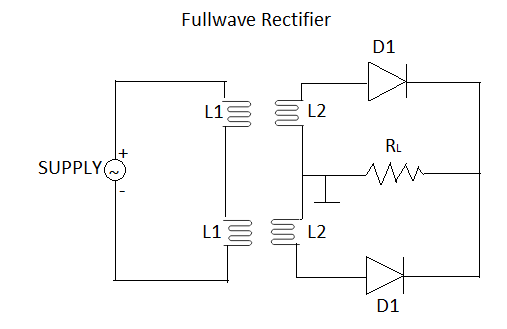
The maximum efficiency of full wave rectifier is:
A.100%
B.25.20%
C.42.2%
D.81.2%
Answer
542.4k+ views
Hint: A rectifier circuit which converts an ac voltage into dc voltage with the help of both half cycles of applied ac voltage is known as full wave rectifier. To calculate the efficiency of a full wave rectifier we need to calculate the ratio of DC power to AC power which will be discussed in the below section.
Formula used:
Efficiency
$\Rightarrow \eta =\dfrac{{{P}_{DC}}}{{{P}_{AC}}}\times 100$
$\Rightarrow {{P}_{DC}}=\dfrac{{{V}_{DC}}^{2}}{{{R}_{L}}}$
$\Rightarrow {{P}_{AC}}=\dfrac{{{V}_{RMS}}^{2}}{{{R}_{L}}}$
Complete answer:
In a full wave rectifier circuit two diodes are used from which one conducts during one half cycle and another in the next half cycle of AC voltage. During positive half cycle diode one becomes forward biased and diode two will become reverse biased hence only diode one will conducts in the circuit and diode two will remain off in that time period and load current flows through diode one with some voltage drop across resistance, but in negative half cycle situation gets reversed and diode one will become reverse and diode two will become forward biased hence only diode two will conducts and load current will flow from diode two only.
Now to calculate efficiency of full wave rectifier we have,
DC Power can be defined as,
$\Rightarrow {{P}_{DC}}=\dfrac{{{V}_{DC}}^{2}}{{{R}_{L}}}$
$\Rightarrow {{V}_{DC}}=\dfrac{{{V}_{M}}}{\pi }$
Here, ${{V}_{DC}}$(DC voltage across the load resistance), ${{V}_{M}}$(Voltage applied) and ${{R}_{L}}$(load resistance).
AC Power can be defined as,

$\Rightarrow {{P}_{AC}}=\dfrac{{{V}_{RMS}}^{2}}{{{R}_{L}}}$
$\Rightarrow {{V}_{RMS}}=\dfrac{{{V}_{M}}}{\sqrt{2}}$
Here,${{V}_{RMS}}$ (RMS voltage at the load resistance), ${{V}_{M}}$(Voltage applied) and ${{R}_{L}}$(load resistance).
Now, efficiency is the ratio of dc output to ac output so,
$\Rightarrow \eta =\dfrac{{{P}_{DC}}}{{{P}_{AC}}}$
$\Rightarrow \eta =\dfrac{\dfrac{{{V}_{DC}}^{2}}{{{R}_{L}}}}{\dfrac{{{V}_{RMS}}^{2}}{{{R}_{L}}}}=\dfrac{{{V}_{DC}}^{2}}{{{V}_{RMS}}^{2}}$
By putting value of ${{V}_{DC}}$and ${{V}_{RMS}}$ we have,
$\Rightarrow \eta =\dfrac{{{\left[ {}^{2{{V}_{M}}}/{}_{\pi } \right]}^{2}}}{{{\left[ {}^{{{V}_{M}}}/{}_{\sqrt{2}} \right]}^{2}}}$
$\Rightarrow \eta =\dfrac{8}{{{\pi }^{2}}}=0.812$
To calculate in percentage we just need to multiply by 100 so we have,
$\Rightarrow \eta =0.812\times 100=81.2%$
$\Rightarrow \eta =81.2%$
$\therefore $ The efficiency of a full wave rectifier is 81.2 % so option (D) is correct.
Note:
The output of a full wave rectifier can contain both ac and dc components which can cause damage to many appliances which can’t tolerate high value of ripple so to further rectify the output the ac components or ripple can be minimized by using filters. The common filters are inductor filter, LC filter, CLC filter and capacitor filter.
Formula used:
Efficiency
$\Rightarrow \eta =\dfrac{{{P}_{DC}}}{{{P}_{AC}}}\times 100$
$\Rightarrow {{P}_{DC}}=\dfrac{{{V}_{DC}}^{2}}{{{R}_{L}}}$
$\Rightarrow {{P}_{AC}}=\dfrac{{{V}_{RMS}}^{2}}{{{R}_{L}}}$
Complete answer:
In a full wave rectifier circuit two diodes are used from which one conducts during one half cycle and another in the next half cycle of AC voltage. During positive half cycle diode one becomes forward biased and diode two will become reverse biased hence only diode one will conducts in the circuit and diode two will remain off in that time period and load current flows through diode one with some voltage drop across resistance, but in negative half cycle situation gets reversed and diode one will become reverse and diode two will become forward biased hence only diode two will conducts and load current will flow from diode two only.
Now to calculate efficiency of full wave rectifier we have,
DC Power can be defined as,
$\Rightarrow {{P}_{DC}}=\dfrac{{{V}_{DC}}^{2}}{{{R}_{L}}}$
$\Rightarrow {{V}_{DC}}=\dfrac{{{V}_{M}}}{\pi }$
Here, ${{V}_{DC}}$(DC voltage across the load resistance), ${{V}_{M}}$(Voltage applied) and ${{R}_{L}}$(load resistance).
AC Power can be defined as,

$\Rightarrow {{P}_{AC}}=\dfrac{{{V}_{RMS}}^{2}}{{{R}_{L}}}$
$\Rightarrow {{V}_{RMS}}=\dfrac{{{V}_{M}}}{\sqrt{2}}$
Here,${{V}_{RMS}}$ (RMS voltage at the load resistance), ${{V}_{M}}$(Voltage applied) and ${{R}_{L}}$(load resistance).
Now, efficiency is the ratio of dc output to ac output so,
$\Rightarrow \eta =\dfrac{{{P}_{DC}}}{{{P}_{AC}}}$
$\Rightarrow \eta =\dfrac{\dfrac{{{V}_{DC}}^{2}}{{{R}_{L}}}}{\dfrac{{{V}_{RMS}}^{2}}{{{R}_{L}}}}=\dfrac{{{V}_{DC}}^{2}}{{{V}_{RMS}}^{2}}$
By putting value of ${{V}_{DC}}$and ${{V}_{RMS}}$ we have,
$\Rightarrow \eta =\dfrac{{{\left[ {}^{2{{V}_{M}}}/{}_{\pi } \right]}^{2}}}{{{\left[ {}^{{{V}_{M}}}/{}_{\sqrt{2}} \right]}^{2}}}$
$\Rightarrow \eta =\dfrac{8}{{{\pi }^{2}}}=0.812$
To calculate in percentage we just need to multiply by 100 so we have,
$\Rightarrow \eta =0.812\times 100=81.2%$
$\Rightarrow \eta =81.2%$
$\therefore $ The efficiency of a full wave rectifier is 81.2 % so option (D) is correct.
Note:
The output of a full wave rectifier can contain both ac and dc components which can cause damage to many appliances which can’t tolerate high value of ripple so to further rectify the output the ac components or ripple can be minimized by using filters. The common filters are inductor filter, LC filter, CLC filter and capacitor filter.
Recently Updated Pages
A man running at a speed 5 ms is viewed in the side class 12 physics CBSE

The number of solutions in x in 02pi for which sqrt class 12 maths CBSE

State and explain Hardy Weinbergs Principle class 12 biology CBSE

Write any two methods of preparation of phenol Give class 12 chemistry CBSE

Which of the following statements is wrong a Amnion class 12 biology CBSE

Differentiate between action potential and resting class 12 biology CBSE

Trending doubts
What are the major means of transport Explain each class 12 social science CBSE

Which are the Top 10 Largest Countries of the World?

Draw a labelled sketch of the human eye class 12 physics CBSE

Explain sex determination in humans with line diag class 12 biology CBSE

Explain sex determination in humans with the help of class 12 biology CBSE

Differentiate between homogeneous and heterogeneous class 12 chemistry CBSE




